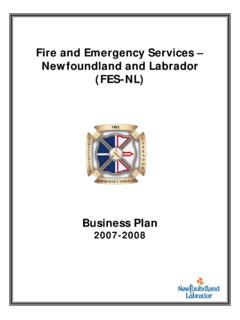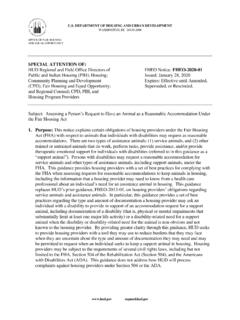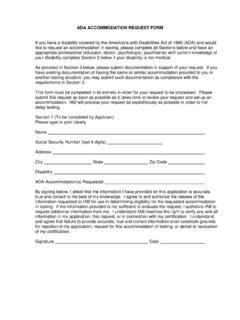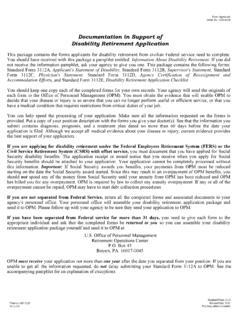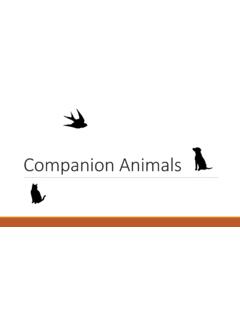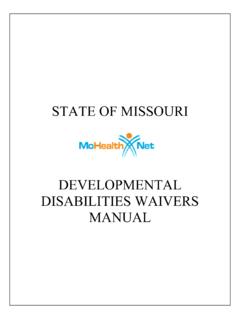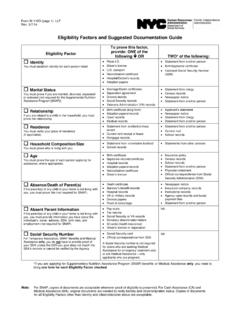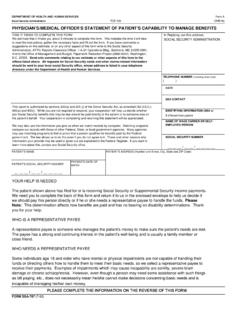Transcription of DSM-5 changes in Intellectual Disability & Learning Disabilities
1 + DSM-5 changes in Intellectual Disability & Learning Disabilities Member of DSM-5 Work Group on ADHD & cross-appointed to Neurodevelopmental Disorders Work Group (for SLD) Professor Emerita, University of Toronto, & Senior Scientist, The Hospital for Sick Children , Toronto, CANADA + Presenter Disclosure Speaker: Rosemary Tannock, PhD Relationships with commercial interests: Grants/Research support : None/ Cogmed; Purdue Pharma Speakers Bureau/Honoraria: None/ Shire; Janssen-Ortho Consulting Fees: Biomed Central (publisher) Editors Advisory Group Other: Royalties: Springer, as Co-Editor of book (Behavioral Neuroscience of ADHD and its Treatment, 2011) Member DSM-5 Workgroup on ADHD, & liaison member to Neurodevelopmental Disorders workgroup (for Learning Disorders) Member International Steering Committee for WHO International Classification of Functioning (ICF)-Core Set for ADHD Affiliate member WHO ICD-11 Specific Learning Disorders subcommittee + What is the DSM?
2 The DSM Diagnostic & Statistical Manual - serves as a universal authority for psychiatric diagnosis in North America, South America, Australia, and many other European countries. The Manual specifies the diagnostic criteria for each recognized mental health disorder, and so provides a systematic & reliable approach to diagnosis Treatment recommendations, as well as payment by health care providers, are often determined by DSM classifications, so this tool has significant practical 3 + Why is the DSM-5 important? The Newfoundland & Labrador Department of Education and Early Childhood Development recognizes the revised conceptualization & criteria as published in the Diagnostic and Statistical Manual of Mental Disorders ( DSM-5 ) for: Intellectual Disability (ID) Specific Learning Disorder (SLD) 4 + Diagnosis: definition The identification of the nature of an illness or other problem by examination of the symptoms The act or process of identifying or determining the nature and cause of a disease or injury through evaluation of patient history, examination, & review of laboratory data.
3 A diagnosis may indicate the need for & type of medical treatment; it does not indicate the person s Learning needs. Diagnosis is a Regulated Health Act 5 + Exceptionality Departments of Education use the term exceptionality to identify patterns of strengths and needs common to groups of students, as determined through comprehensive assessment. These unique strengths & needs may be: cognitive, emotional, behavioural, medical, social, or physical Students with an exceptionality may access a range of school based services depending on degree of severity. 6 + Educational versus Clinical assessment of ID and SLD In Education, assessment is designed to: Determine/confirm whether a student s difficulties result from an exceptionality Clarify how the student s exceptionality impacts Learning & functioning in the school context Provide information that is relevant for & guides program planning In Clinical Practice: assessment is designed to rule in/rule out a diagnosis it provides information that is relevant for medical treatment.
4 Psychological assessment may also provide information relevant for educators & program planning 7 + The History of DSM The World Health Organization s (WHO) was the first to clarify diagnostic criteria for medical disorders: International Classification of Diseases (ICD) Lists specific diagnostic criteria for all medical diseases, including mental disorders Each country may publish its own diagnostic manual based on the ICD: can modify the ICD provided the changes do not change its intent: When the ICD is updated, each country updates their own diagnostic manual - compatible with the new ICD version USA:American Psychiatric Association was assigned responsibility components of the ICD related to mental disorders: DSM-5 based on ICD-10 (ICD-11) DSM5 Organizational Structure DSM5 Task Force Chair: David J. Kupfer; Vice-Chair: Darrell Regier Task Force Members: 13 Work-group chairs & experts Study Groups = 6 Dx Spectra Lifespan & Development Gender & culture Psychiatric & general medical Impairment Assessment Diagnostic assessment instruments Work Groups = 13 Neurodevelopmental Disorders ADHD & Disruptive Behavior Disorders Scientific Advisory Committee Clinical & Public Health Committee 9 + Each work group was asked Determine, based on members clinical and research knowledge, what works and what doesn t work for their assigned diagnoses in DSM-IV-TR Assess new research developments and clinical issues that have arisen since 1992 Develop a research plan to investigate these issues, resolve problems, etc.
5 , using literature reviews and secondary data analyses 10 + NEW DSM PROCESS: Required detailed documentation of scientific evidence to support every recommended change Antecedent Validators Familial aggregation/co-aggregation (family, twin, adoption studies Socio-demographic and cultural factors Environmental risk factors Concurrent Validators Comorbidity Cognitive factors Predictive Validators Diagnostic stability Response to Intervention (explanatory text plus tabulated & rated studies submitted to Scientific Review Committee & Public Health Committee for approval/rejection) For major diagnostic changes : need evidence for 4 high-priority categories: Familial/genetic; diagnostic stability; course of illness; response to treatment Rating Scale: strong support ; moderate (acceptable) support ; modest (questionable) support ; 4. = limited (not justified) support ; 5.)
6 = poor support (not to include) 11 + Major changes in emphasis in DSM-5 Sensitive to & reflect: developmental (lifespan) changes , sex differences cultural/international differences 12 + DSM-5 : Subtypes versus Specifiers 13 Specifiers: provide an opportunity for the clinician to define more homogeneous sub-groupings of individuals with a specific disorder Provide information about the range of problems manifest at the time of assessment Provide information relevant for intervention & management Subtypes: Distinctive Mutually exclusive Jointly exhaustive + Specify Severity Severity specifiers are provided to guide clinicians in rating the severity, frequency, duration, symptom count, & likely amount of support required to optimize functioning 14 + DSM Process: a balancing act Scientific evidence Clinical Utility & Experience Diagnostic criteria remain as behavioral descriptors: potential etiological factors are summarized in the text 15 + DSM-5 : Neurodevelopmental Disorders 16 Neurodevelopmental Disorders Intellectal Disability Communication Disorders Autism Spectrum Disorders Attention-Deficit Hyperactivity Disorder Specific Learning Disorders Motor Disorders Reflects developmental process + PRACTICE POINT.
7 DSM-5 changes in Intellectual Disability & Specific Learning Disorder Reflects the growing concern about excessive & inappropriate reliance on IQ cut-offs for diagnosis Encourages clinicians to take into account various sources of test & measurement error Encourages clinicians to consider & integrate information from a broader array of sources 17 + Quiz # 1 (discuss in small group) is the difference between a diagnosis & an exceptionality? one major advance in the DSM-5 revision process compared to the process used in previous revisions of DSM & why is this important for psychologists & educators? is the difference between DSM-5 Subtypes & Specifiers? 18 + Questions, concerns, comments? 19 + Intellectual Disabilities changes made in DSM-5 20 + Newfoundland & Labrador Department of Education & Early Childhood Development Exceptionality: Cognitive Disorder Based on DMS-IV-TR significantly subaverage Intellectual functioning an IQ of approximately 70 or below.
8 Significant limitations in adaptive functioning in at least 2 of the following skill areas: communication self direction self care functional academic skills home living work social/interpersonal skills leisure use of community resources health & safety onset must occur before age 18 years 21 + Plan for next set of slides Overview of major changes in DSM-5 Intellectual Disability (ID) Conceptualization & Diagnostic Criteria for ID Rationale for changes Practice Points: Cautions in application of the criteria 22 NB a few slides indicated by * are not in your handout, so I will slow down for you to make notes! + Overview of major changes in DSM-5 Intellectual Disability Its name formerly Mental Retardation derogatory, stigmatizing Better alignment with ICD, other professional disciplines, & organizations (AAIDD, US Dept Education Its impact on a person s functioning Cognitive, social, practical (self-management) changes in criteria to encourage more comprehensive assessment and decrease reliance on psychometrics IQ scores Specifiers for severity 23 + Comparison of definitions Criteria DSM-IV- DSM-5 Name [Mental Retardation] COGNITIVE DISORDER Intellectual Disabilities A: Intellectual function Significantly subverage Intellectual functioning IQ 70 Deficits (reasoning, problem- solving, planning, abstract thinking etc) confirmed by clinical assessment & individual standardized testing (IQ: 70 5) Intellectual profile B.)
9 Adaptive function Deficits in 2 areas Deficits in adaptive function result in failure to meet socio-cultural standards ( , lack of judgment) & related to Intellectual impairments C: Age at onset Before age 18 During developmental period Severity Based on IQ Based on adaptive function 24 + DSM-5 : Intellectual Disabilities Intellectual Disabilities Intellectual Disability Intellectual developmental disorder Global developmental delay Unspecified Intellectual Disability 25 This term is in common use by medical, educational, other professionals, lay public > 5yrs of age when reliable assessment not possible < 5 yrs of age when reliable assessment not possible + DSM-5 Intellectual Disability Is not defined by psychometric test score alone In other words Intellectual Disability is not defined solely by low full-scale IQ score on IQ test ( , IQ 70) In practice, many clinicians do not assess adaptive functioning (or discount it) if the full-scale IQ score was 70-75 or higher 26 + DSM-5 : Intellectual Disability Concept & Diagnostic Criteria A disorder of thinking & reasoning.
10 Characterized by gullibility - inability to recognize & avoid risk - & by limitations in everyday reasoning & social judgment Must meet 3 criteria: Intellectual deficits Adaptive functioning deficits Age at onset in developmental period 27 + Intellectual Disability : DSM-5 diagnostic criteria in Intellectual functions (reasoning, problem-solving, planning, abstract thinking, judgment, academic Learning , Learning from experience) Confirmed by clinical assessment & individualized standardized IQ testing 28 + Intellectual Disability : taking test & measurement error into account IQ test scores need to be interpreted within a reliability range of 5 points at the 95th percentile Thus the upper full-scale IQ ceiling for ID is set at 75 (5th %ile) That is, a ceiling of 2 standard deviations below the mean can be met with an IQ score as high as 75 Need to correct for inflated scores due to use of a test with out-of-date norms (Flynn effect) Consider lowering IQ score by points for every year of norm obsolescence Need to keep in mind that full-scale IQ score may be invalid when there is excessive scatter among subscales 29 + Limitations of IQ test scores.

